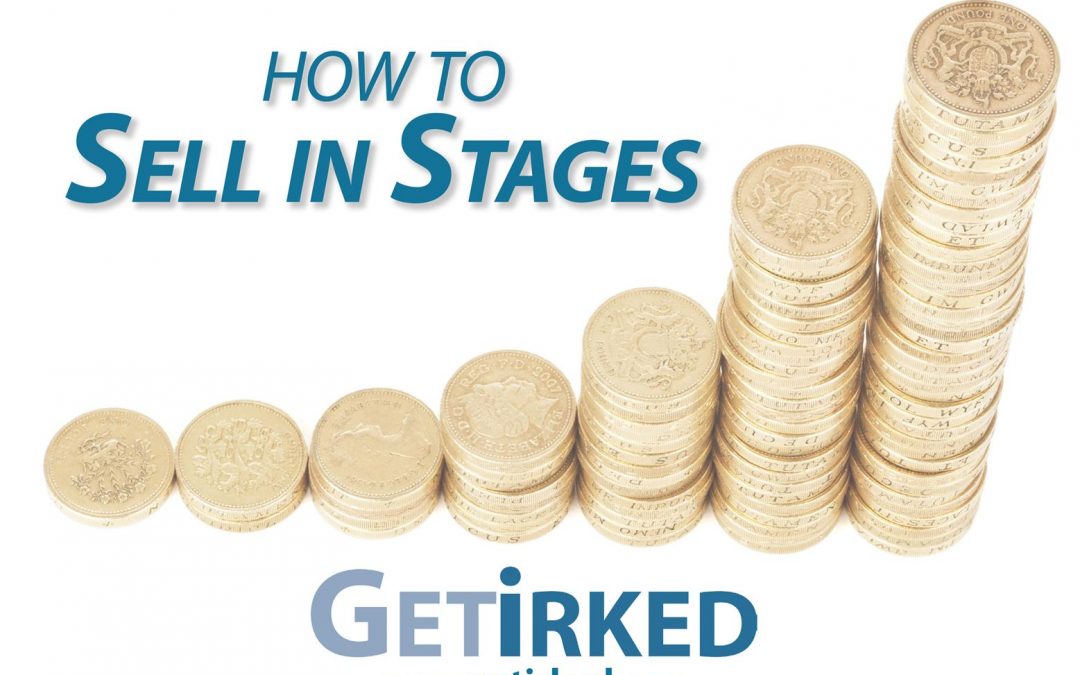Originally posted April 9, 2019. Last Updated June 13, 2021
What is Selling in Stages?
Astute readers of
Selling in Stages is the reverse concept of Buying in Stages: Sell small portions of a position as its price reaches higher and higher levels above the investor’s per-share basis.
Why Sell in Stages?
If the most important priority facing investors and traders is risk management, the second priority should be removing emotion from investing.
The Fear of Missing Out – or FOMO – can result in entering an investment too early or putting too much capital to work too soon at the buying stage, however, emotions can also be incredibly painful on the selling stage, too. Selling too soon and missing upside profits can cause investors and traders to kick themselves for not waiting a little longer.
The danger of waiting too long is the possibility of having a position reverse direction, start heading lower, and leaving the investor kicking themselves for not taking their profits sooner.
Bulls make money and Bears make money, but Hogs get slaughtered.
The concept behind this adage is that there’s always money to be made on the way up and the way down, but any investor who waits too long will likely lose money once the investment’s price action reverses direction – and price always changes direction before we’re ready for it.
How to Sell in Stages?
Just like everything in trading or investing, each investor needs to choose the strategy that suits his or her style.
Pyramid Selling
Take increasing quantities of profit as a position gains to specific levels.
For example, if an investor owns 100 shares of stock XYZ, they could sell 5 shares at a 5% gain, 10 shares at a 10% gain, 15 shares at a 20% gain and so on.
By selling more at each level, the investor lowers the per-share cost of their position, reduces their risk, and takes advantage of the increasing gains while avoiding FOMO by keeping some of their position on the table.
Using Limit Sell Orders take profits at the specific levels on the way up while a Stop Loss Order should be used to pull all investing capital at a lower level in case the position reverses direction.
Endgame Strategy: Sell in stages until the entire original investment has been taken off the table and then let the profits run. Use a Trailing Stop (TS) order at a lower level to close the remainder of the position if (when) the investment changes direction.
Trailing Stop (TS) Orders
We go into more detail about Trailing Stop (TS) Orders and other kinds of Contingent Orders in our feature piece about the topic, however, in brief, a Trailing Stop order follows a position at a preset lower price level in either terms of percentage or points.
As an investment’s price increases, the stop selling price increases accordingly. If the investment’s price reverses direction, the stop’s selling price doesn’t change, and if the investment’s price continues down to hit the stop price, the order fills and closes the position – all automatically.
For example: If stock XYZ was $100 and an investor puts in a Trailing Stop at 2%, the order will fill if the XYZ drops to $98.
- If XYZ increases in price to $110, the Trailing Stop will also increase to $107.80 ($110 – 2%).
- If XYZ changes direction at $110 and drops to $107.80 or lower, the order will fill and the position will sell.
- Instead of using a limit order at a higher price and risking the position never reaches that level, the investor sacrifices 2% of upside (the difference between the position’s highest price and the Trailing Stop increment), but protects against an additional price pullback.
Of course, there’s always the possibility of the stock pulling back, filling the Trailing Stop, and then heading higher. Investors need to choose levels that they’re comfortable with while also practicing risk management at all times.
Trailing Stop orders can offer investors and traders a method to capture additional upside while simultaneously protecting against downside risk.
Important Downside Risk of Trailing Stop Orders
While many brokerages offer Trailing Stops, few (if any) brokers offer Trailing Stops with limit orders. In other words, when a Trailing Stop’s price is hit, the order is converted to a market order rather than a limit order.
The risk here is that if a stock receives bad news when the market is closed and the price opens much, much lower, the position will sell at that low price, even if the stock regains its price in market trading. Market orders should be rarely, if ever, used, however Trailing Stops typically incorporate them, unfortunately.
You Do You…
Just like many areas of life, there is no one right way to take profits on
Get Irked recommends investors consult with professional financial advisers as we are absolutely not professionals. All investments carry risk, and investors should only risk funds they can lose entirely.

